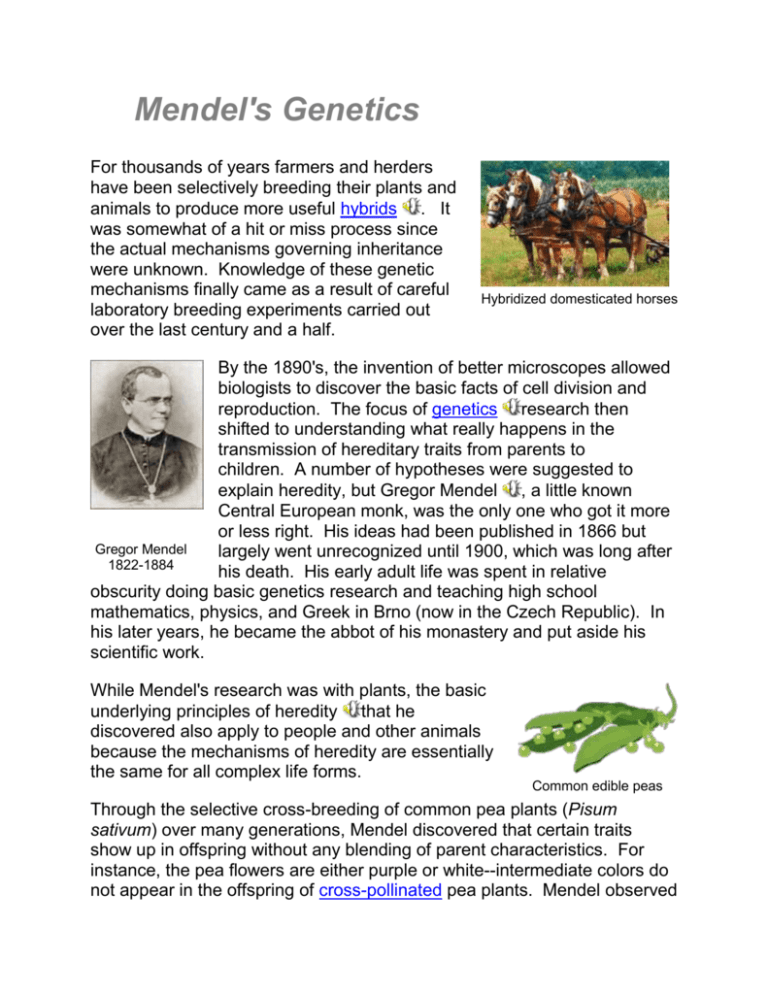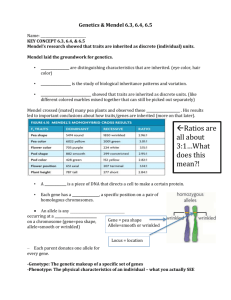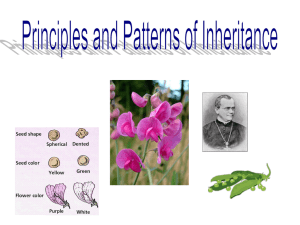File
advertisement

Mendel's Genetics For thousands of years farmers and herders have been selectively breeding their plants and animals to produce more useful hybrids . It was somewhat of a hit or miss process since the actual mechanisms governing inheritance were unknown. Knowledge of these genetic mechanisms finally came as a result of careful laboratory breeding experiments carried out over the last century and a half. Hybridized domesticated horses By the 1890's, the invention of better microscopes allowed biologists to discover the basic facts of cell division and reproduction. The focus of genetics research then shifted to understanding what really happens in the transmission of hereditary traits from parents to children. A number of hypotheses were suggested to explain heredity, but Gregor Mendel , a little known Central European monk, was the only one who got it more or less right. His ideas had been published in 1866 but Gregor Mendel largely went unrecognized until 1900, which was long after 1822-1884 his death. His early adult life was spent in relative obscurity doing basic genetics research and teaching high school mathematics, physics, and Greek in Brno (now in the Czech Republic). In his later years, he became the abbot of his monastery and put aside his scientific work. While Mendel's research was with plants, the basic underlying principles of heredity that he discovered also apply to people and other animals because the mechanisms of heredity are essentially the same for all complex life forms. Common edible peas Through the selective cross-breeding of common pea plants (Pisum sativum) over many generations, Mendel discovered that certain traits show up in offspring without any blending of parent characteristics. For instance, the pea flowers are either purple or white--intermediate colors do not appear in the offspring of cross-pollinated pea plants. Mendel observed seven traits that are easily recognized and apparently only occur in one of two forms: 1. flower color is purple or white 2. flower position is axil or terminal 3. stem length is long or short 4. seed shape is round or wrinkled 5. seed color is yellow or green 6. pod shape is inflated or constricted 7. pod color is yellow or green This observation that these traits do not show up in offspring plants with intermediate forms was critically important because the leading theory in biology at the time was that inherited traits blend from generation to generation. Most of the leading scientists in the 19th century accepted this "blending theory." Mendel picked common garden pea plants for the focus of his research because they can be grown easily in large numbers and their reproduction can be manipulated. Pea plants have both male and female reproductive organs. As a result, they can either self-pollinate themselves or crosspollinate with another plant. In his experiments, Mendel was able to selectively cross-pollinate purebred plants with particular traits and observe the outcome over many generations. This was the basis for his conclusions about the nature of genetic inheritance. Reproductive structures of flowers In cross-pollinating plants that either produce yellow or green pea seeds exclusively, Mendel found that the first offspring generation (f1) always has yellow seeds. However, the following generation (f2) consistently has a 3:1 ratio of yellow to green. This 3:1 ratio occurs in later generations as well. Mendel realized that this underlying regularity was the key to understanding the basic mechanisms of inheritance. He came to three important conclusions from these experimental results: 1. that the inheritance of each trait is determined by "units" or "factors" that are passed on to descendents unchanged (these units are now called genes ) 2. that an individual inherits one such unit from each parent for each trait 3. that a trait may not show up in an individual but can still be passed on to the next generation. It is important to realize that, in this experiment, the starting parent plants were homozygous for pea seed color. That is to say, they each had two identical forms (or alleles ) of the gene for this trait--2 yellows or 2 greens. The plants in the f1 generation were all heterozygous . In other words, they each had inherited two different alleles--one from each parent plant. It becomes clearer when we look at the actual genetic makeup, or genotype , of the pea plants instead of only the phenotype , or observable physical characteristics. Note that each of the f1 generation plants (shown above) inherited a Y allele from one parent and a G allele from the other. When the f1 plants breed, each has an equal chance of passing on either Y or G alleles to each offspring. With all of the seven pea plant traits that Mendel examined, one form appeared dominant over the other, which is to say it masked the presence of the other allele. For example, when the genotype for pea seed color is YG (heterozygous), the phenotype is yellow. However, the dominant yellow allele does not alter the recessive green one in any way. Both alleles can be passed on to the next generation unchanged.











